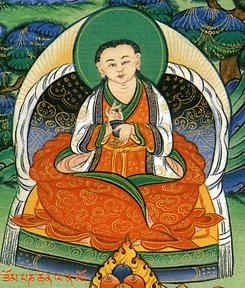Rongzom Chökyi Zangpo: Difference between revisions
Jump to navigation
Jump to search
No edit summary |
No edit summary |
||
| Line 1: | Line 1: | ||
[[Image:Rongzom.JPG|frame|'''Rongzom Chökyi Zangpo''']] | |||
'''Rongzom Chökyi Zangpo''' (''rong zom chos kyi bzang po'') - lived in the 11th century. His dates have been given as 1012-1088. He was born in Tsang rong and met [[Atisha]] in his youth. He mastered the teachings of both [[Nyingma]] and [[Sarma]] traditions. He translated many works on secret mantra, some of which are preserved in the [[Kangyur]] and some of which did not survive. Likewise, many of his original writings have sadly been lost, but among those which are still to be found today are his commentary on the ''[[Guhyagarbha Tantra]]'', his introduction to [[mahayana]] called ''Introduction to the Way of the Great Vehicle'' (''theg pa chen po'i tshul la 'jug pa'') and his famous ''Establishing All Appearances as Divine'' (''snang ba lhar sgrub''). | '''Rongzom Chökyi Zangpo''' (''rong zom chos kyi bzang po'') - lived in the 11th century. His dates have been given as 1012-1088. He was born in Tsang rong and met [[Atisha]] in his youth. He mastered the teachings of both [[Nyingma]] and [[Sarma]] traditions. He translated many works on secret mantra, some of which are preserved in the [[Kangyur]] and some of which did not survive. Likewise, many of his original writings have sadly been lost, but among those which are still to be found today are his commentary on the ''[[Guhyagarbha Tantra]]'', his introduction to [[mahayana]] called ''Introduction to the Way of the Great Vehicle'' (''theg pa chen po'i tshul la 'jug pa'') and his famous ''Establishing All Appearances as Divine'' (''snang ba lhar sgrub''). | ||
Revision as of 02:30, 15 March 2007

Rongzom Chökyi Zangpo (rong zom chos kyi bzang po) - lived in the 11th century. His dates have been given as 1012-1088. He was born in Tsang rong and met Atisha in his youth. He mastered the teachings of both Nyingma and Sarma traditions. He translated many works on secret mantra, some of which are preserved in the Kangyur and some of which did not survive. Likewise, many of his original writings have sadly been lost, but among those which are still to be found today are his commentary on the Guhyagarbha Tantra, his introduction to mahayana called Introduction to the Way of the Great Vehicle (theg pa chen po'i tshul la 'jug pa) and his famous Establishing All Appearances as Divine (snang ba lhar sgrub).